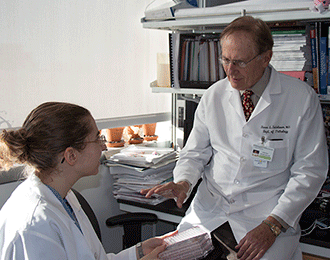
Scientists have developed an approach to creating treatments for osteoporosis and autoimmune diseases that may avoid the risk of infection and cancer posed by some current medications.
Researchers at Washington University School of Medicine in St. Louis redesigned a molecule that controls immune cell activity, changing the molecule’s target and altering the effects of the signal it sends.
Current treatments for bone loss and autoimmune disorders block these molecules and their signals indiscriminately, which over time increases the risk of infections and cancer. The new approach may let scientists selectively block the bad signals that cause or contribute to disease and enhance good signals that defend the body against cancer and infections such as tuberculosis.
“The molecule we studied controls cells linked to bone weakening, but it belongs to a family of proteins implicated in conditions such as rheumatoid arthritis, psoriasis, Crohn’s disease and asthma,” said first author Julia Warren, an MD/PhD student. “Therefore, this has broad implications for how we might design therapies for a wide variety of ailments.”
The findings appear online in Science Signaling.
The researchers worked with RANKL, a protein that activates cells that dismantle bone. Normally this makes it possible for another group of cells to rebuild the bone, renewing the skeleton and maintaining its strength as the body ages. But if the bone dismantlers become more active than the bone builders, weakening of the skeleton and bone loss result.
Co-senior authors Steven Teitelbaum, MD, and Daved Fremont, PhD, showed that copies of RANKL naturally come together in clusters of three. To send a signal, which triggers the development of bone-dismantling cells, each copy of RANKL in the cluster has to bind to a copy of a receptor, which passes on the signal.
To see if they could take advantage of this requirement, the researchers mutated individual copies of the RANKL protein to make them better or worse at hooking up with the receptor. They then joined together two copies of the protein that were very good at attracting and holding onto the receptor with a third copy that did not bind to the receptor.
“When we gave this to mouse cells, naturally occurring RANKL couldn’t compete with the drawing power of engineered RANKL,” said Teitelbaum, the Wilma and Roswell Messing Professor and director of the Division of Anatomic and Molecular Pathology. “But the new clusters still couldn’t send a signal because the third copy of the protein in each cluster was unable to connect to the receptor.”
The new clusters kept two copies of the receptor busy trying to open the signaling circuit without ever letting a third copy of the receptor finish the process. Consequently, formation of bone-degrading cells was blocked. When the scientists injected mice with the new clusters, the mice stopped making the cells and breaking down bones.
In contrast, injecting copies of the cluster in which all copies of the protein latched tightly to the receptor increased the activity of the bone-dismantling cells.
The researchers also worked with a naturally occurring decoy receptor for RANKL. When this receptor binds to the protein, it blocks its signal. This decreases the number of times the signal is sent.
“A major design challenge for our project was to develop a version of RANKL that would not bind to this decoy receptor,” said Fremont, an associate professor of pathology and immunology. “Julia was able to select versions of RANKL that were significantly better at binding to the normal receptor but were nevertheless incapable of binding to the decoy receptor.”
According to the researchers, their ability to do this suggests the approach may help design treatments for other diseases that are controlled by similar mechanisms.
“That’s the home run here,” Teitelbaum said. “This is a way we can selectively activate one receptor and block another.”
Warren JT, Nelson CA, Decker CE, Zou W, Fremont DH, Teitelbaum SL. Manipulation of receptor oligomerization as a strategy to inhibit signaling by TNF superfamily members. Science Signaling, Aug. 19, 2014.
Washington University School of Medicine’s 2,100 employed and volunteer faculty physicians also are the medical staff of Barnes-Jewish and St. Louis Children’s hospitals. The School of Medicine is one of the leading medical research, teaching and patient-care institutions in the nation, currently ranked sixth in the nation by U.S. News & World Report. Through its affiliations with Barnes-Jewish and St. Louis Children’s hospitals, the School of Medicine is linked to BJC HealthCare.